M/C Galapagos Seaman Journey is a first class catamaran that began sailing the Galapagos Islands in January 2008. It is a Boutique Yacht Catamaran offering superior comfort, size, style, and stability. The Galapagos Seaman Journey makes it possible to enjoy several cruises in the Galapagos with different itineraries that include amazing land tours on most of the Galapagos Islands. During these Galapagos Cruises, guests encounter many endemic species like Galapagos Giant Tortoises, Penguins, Land and Marine Iguana´s, Frigate Birds, Blue Footed Boobies, and much more!
During one of the cruises each guest can enjoy the well-furnished areas offering comfort and privacy. Galapagos Seaman Journey has a maximum capacity of 16 passengers allowing both intimacy and camaraderie at the same time.
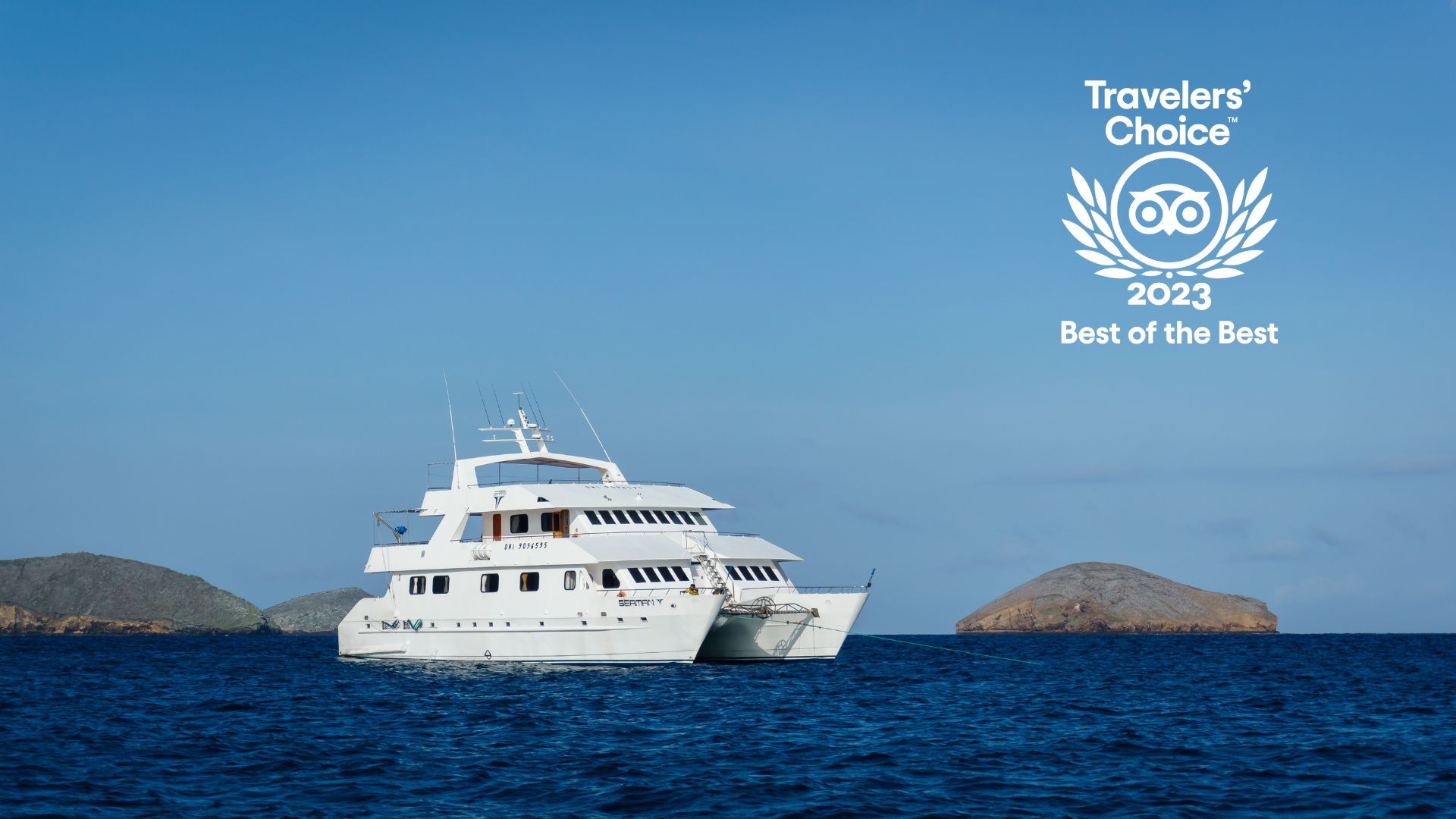
We have several resting areas for those who are looking for a quiet place to relax during their Galapagos trip with family and friends in the lazy mid-afternoon sun, or likewise after a busy day of swimming, snorkeling, kayaking, or walking on one of the Galapagos Islands.
To check out the gorgeous ocean views with fellow shipmates, guests can spend some time on the liveaboards’ spacious sundecks. Whether they feel like getting a little sun on their vacation, or want the best place to enjoy the gorgeous sunsets over the Galapagos Islands, our sundecks are the best place to be.
For the adults who might want to relax and kick back, we offer a great bar and lounge area where they are served by our bartender who will be happy to attend to all their needs and desires whilst you relax.
The M/C Galapagos Seaman Journey, another jewel from the well-known Galapagos Journey Fleet, the perfect combination of adventure, comfort, service and excellence!
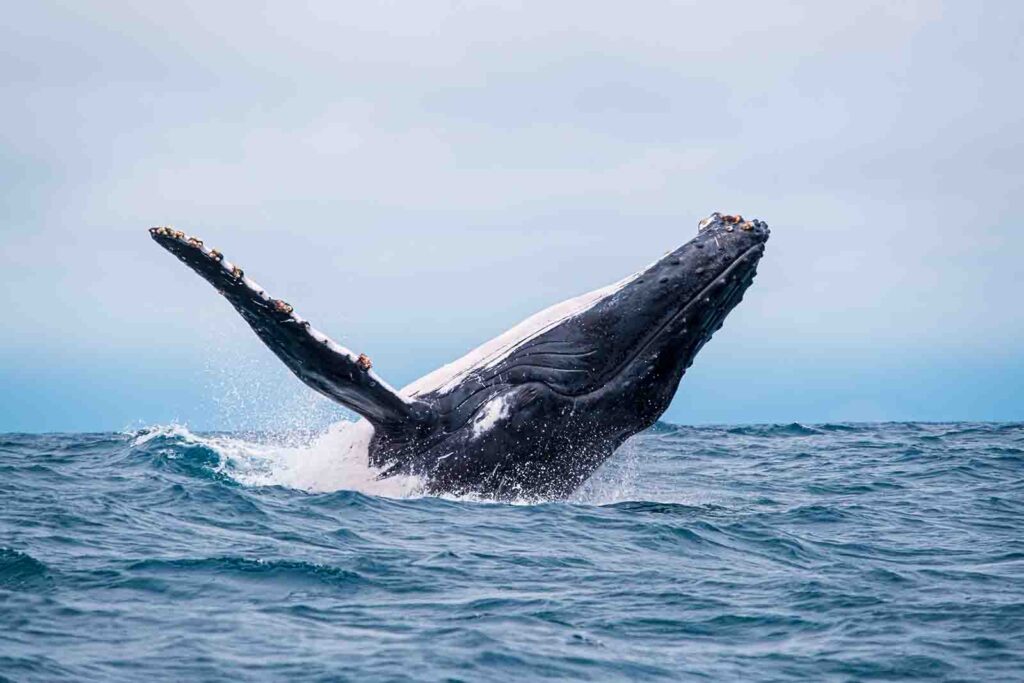
We invite our guests to participate in meaningful conservation efforts through our partner ship with the Galapagos’ Conservation Trust. Through the Happy Whale program, you can help track and identify marine mammals, contributing to vital research about these magnificent creatures. Our Garbology program allows participants to engage in understanding and reducing ocean plastic pollution, making your vacation both enjoyable and purposeful.
The Seaman Journey takes pride in its commitment to sustainability and local sourcing . Our exclusive hydroponic plantation on San Cristobal Island provides fresh, organic produce for our onboard dining experience. This unique farm-to-table proram not only ensures the finest ingredients for our gourmet meals but also supports sustainable agriculture in the islands and avoids arrival of invasive species.
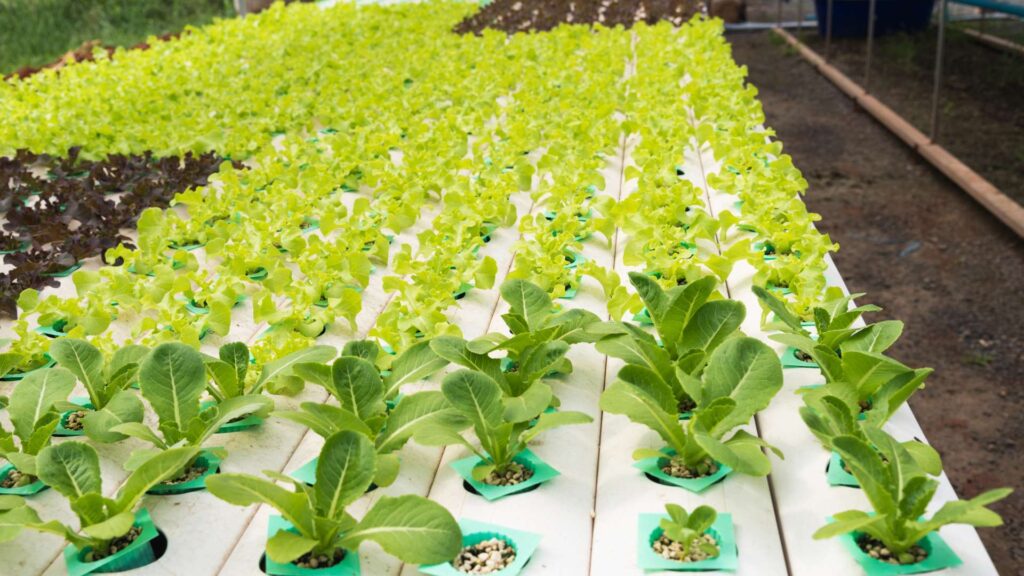
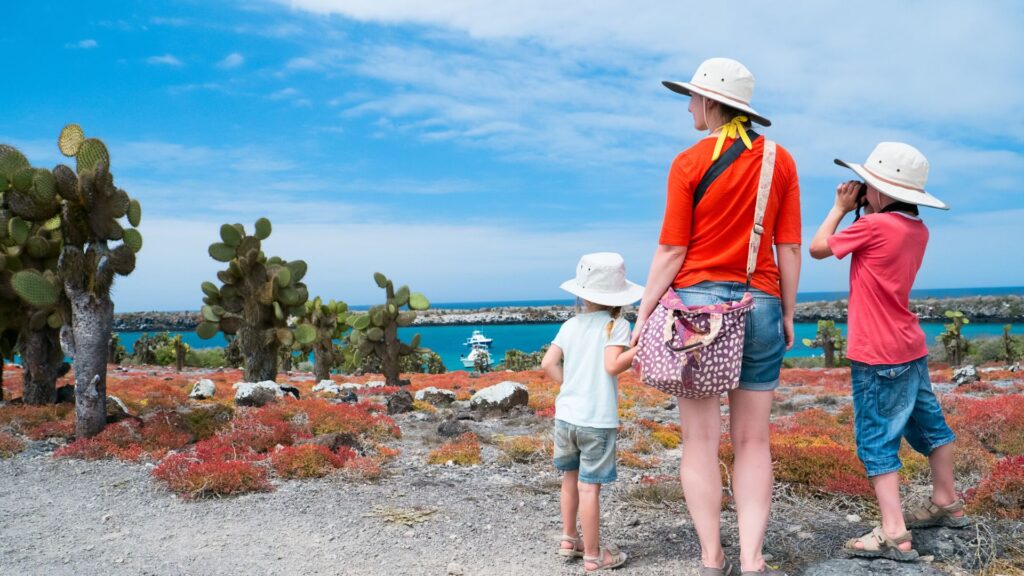
The M/C Galapagos Seaman Journey offers a wide range of itineraries for those looking to see the highlights in short time or for those that want to experience a long cruise on the Galapagos Island. There are three main itineraries that combined all together could be a trip of 15 days

EXCELLENTVerified 11/10 This was one of the best travel experiences of my life. The boat, the crew and the guide - Marco are an 11/10. One of the last remaining local crews and guides in the Galapagos. Without hesitation I would recommend this ship. It was clean, organized, well thought out and planned. Kudos to the sea man journey. You guys are top notch and have left my wife and I speechless !! Marco - the guide - was beyond any expectations. I highly recommend him if you are interested in the history, nature and conservation of this precious place. He made the trip all that more amazing with his knowledge, patience and enthusiasm !! 11/10Verified Real bucket list experience...I need to repeat How could anyone not think the Galapagos is just phenomenal? The only thing that could go wrong would be the tour experience - I'm pleased to say that Seaman Journey matched the splendor of the Galapagos by delivering a fabulous experience.Of course it was about the wildlife, but SJ still had to get us there; guide us; provide excellent accommodation; deliver great food etc ..all in the confines of a relatively small boat!The entire crew were excellent in their individual roles but also in mucking in to general service.The boat was kept spotless (shipshape). Our cabin (8) was on the upper deck (one of 2 double cabins) and was surprisingly spacious. The ensuite was perfectly adequate and maybe better than I expected.The food was great - buffet style but good quality and quantity. The bar was very reasonably priced(!) Which is great when you are a captive audience - and the front of house manager/bar man, Joel, was always smiling.The guiding by Marco was excellent and he provided huge confidence to the group whilst snorkelling - and what an experience that was.My only complaints? The toilet kept blocking...and when on an 8 day cruise that's not great ..but dealt with the appropriate professionalism and humour. Then maybe the whole tipping thing. The rates 'expected' imply that the staff are poorly paid and depend upon the tips. When attracting a global clientele that is a problem - we all have different approaches. We pay a lot for this experience...pay the staff the appropriate amount and build into prices - leave tipping for expression of going above and beyond and real gratitude. That in no way detracts from the experience!Clearly it's not the SJ that is responsible for the wildlife but they complete the experience.This is real bucket list territory...but I might now have to add the eastern loop into my list now. Thanks to the entire crew.Verified New Years Galapagos cruise We had an excellent cruise experience on the Seaman Journey over New Years 2023. The crew and guide were great - they took us on many interesting expeditions both in the water and on land. They were very flexible - we saw whales, dolphins pods, and sea turtles on various detours on the yacht and the pangas. Each meal was a treat - fresh and healthy. The snacks and drinks after every outing were outstanding. Highly recommended.Verified Fantastic Experience This was a wonderful trip! We were on an 11-day cruise, and we enjoyed our experience aboard the Seaman Journey. The crew was attentive. Our cabins were clean and had a surprising amount of storage. The food was good, and there were choices at every meal. The excursions were fantastic. For the first week, we had Camilo as our guide. He was amazing. He knew about the area's natural history, flora and fauna, and geology. I have a science background, and he was able to answer all of my many questions. He was sensitive to people in the group who needed extra help in the water or getting in and out of the boat. The wildlife we saw was abundant and incredible. Camilo made sure we got plenty of time to take photos and ask questions. I am happy we decided on a more extended trip since we saw some islands like Genovesa, which were completely different. It is a very active vacation. We snorkeled and hiked every day. Sunscreen, hats, and good walking shoes are a must. This was a trip of a lifetime, and the crew of Seaman Journey made it so special. Joel, Pablo, Cesar, and our guide Camilo made this a fantastic trip!Verified Loved Our Galapagos Trip On The Seaman Journey! We were hoping for an amazing trip to the Galapagos islands and the Seaman Journey sure delivered! From our guide, Camillo, to Captain Carlos to the entire crew, everyone was very attentive to us and the other passengers. This boat is not in the "luxury" class but was very clean and certainly nice enough. Accomodations were comfortable and the food was plentiful and tasty. Every day was filled with exciting and interesting activities from nature hikes to snorkeling to even some educational lectures. Wildlife was abundant at every turn. On one occasion, the captain went out of his way to put us on a HUGE pod of porpoises that were happy to entertain us with their leaps and jumps for about a half-hour! Very special! Sunsets on the top deck were spectacular and the ship constructed meals and "off" time to give all of the passengers (who had never met before) a chance to get acquinted with each other and really bond as a group.If I would have ANY complaint, it would be with our toilet which really struggled to flush and did leak a bit.Other than that I would eagerly suggest a cruise on the Seaman Journey to anyone wanting an amazing Glapagos Islands experience!Verified Seaman was awesome! Seaman journey & the staff provided an amazing experience. I couldn’t have been more impressed. They thought of every detail and had amazing customer service. I traveled on the boat on my birthday and they decorated my room, made me a cake & the entire boat sang to me. They were incredibly sweet. The staff were very customer service oriented and went above and beyond to think of every detail. The food was fantastic. They also provided cucumber towels and snacks and drinks every time we came back on to the boat. It was incredible! The naturalist guide we had, Marco, was fantastic. He was very knowledgeable of the animals, environment and flora and fauna. He was patient and made sure that everyone who wanted to participate in the activities had an opportunity to. He was very safety conscious as well. He pointed out all kinds of animals while we were snorkeling and hiking. He is very passionate about the Galapagos and he’s a great ambassador. We had one day where the swell was too high to do the planned activities. The staff were so apologetic and obviously there was nothing they could do about it. Even though Mother Nature didn’t cooperate the staff went out of their way to still make it a good day. They were wonderful. 10/10 would recommend the seaman journey & the amazing staff. Big thanks to Joel, Karen, Pablo, Caesar, Kevin, Marco & the captain and chef. Thanks for the trip of a lifetime!Verified Trip of a lifetime. This trip was absolutely amazing. We took our kids (aged 7, 14 and 23). Everyone had an unforgettable experience. We did a 5 day cruise in the western islands. The staff was exceptional. The guests ate meals at a communal table with nice linens and glassware. It helped us to get to know the other guests. A snack and beverage was waiting for us when we returned from each excursion. The rooms exceeded my expectations. My husband and I had an upper room with a large bed. The kids a had rooms with twin beds. They literally had the time of their lives. Anyway I highly recommend this boat and the crew.Verified Amazing Galapagos cruise Excellent 7 night stay on Seaman Journey; all the crew were helpful and efficient; food was really good given it's a small catamaran, and we were given hot or cold drinks and a snack when we got back on board after each excursion (very welcome hot chocolate after snorkelling!); clean cabins and creative towel-art by the lovely Karen! Our guides (changed after the first 3 days as bi-lingual guide needed for second part) Camilo and Mauricio were very knowledgeable and enthusiastic in sharing their Islands with us.I'm guessing you could go more luxury in choice of boat, but don't know why you would - this had everything we needed for a remarkable week. The trips are varied, with snorkelling (snorkel, mask and fins included, extra cost for loan of wet suits - $10/day when we were there - which we needed to be comfortable in November), kayaking, guided walks on the islands and relaxed lecture.I took advantage of the sea sickness tablets each night and was fine, even when it was a bit choppy. I also used ear plugs as it can be noisy at night when the boat tends to move between Islands.Drinks other than tea, coffee, hot chocolate and water are charged for and they only take cash (US Dollars), so make sure you have enough cash to cover your costs.This cruise gave us an amazing experience and I'd recommend it to anyone who loves wildlife holidays!Verified Excellent Crew, Boat and Itineraries! Our long awaited trip to the Galapagos was amazing and the Seaman Journey (7 night around eastern islands was the amazing. Our naturalist guide Camilo was able to bring valuable perspectives into the islands and their wildlife all while keeping things fun and safe! The rest of the crew was always friendly and helpful --- and the food was so much more than we were expecting --- very tasty!We would highly recommend the Seaman Journey for a Galapagos cruise and would love to come back some day to explore the other islands of the Galapagos. The overall experience was top-notch and well worth the cost.Verified Superb Galapagos experience Ok, you're not at the "fancy" end of the tour boats of the galapagos here, but if you're expecting that - it's perfect.Boat is small, capacity for not many more than the 12 guests we had I'd say. It's a little dated, and you'll get a two single beds in most rooms - but it's fine for what you need. Note: the boat is small, so if it's wavy, you'll know about it. Take a free sea sickness pill if you need it (we didn't). You definitely need earplugs to sleep, it's noisy at night on the move.Food was fine for the week, especially given it's a small boat at sea! My wife is vegetarian and she also enjoyed the food. One chap had a birthday, and they made him a sponge cake, which I thought was good going.The thing you care about: the excursions. The guide was excellent, the trips safe and well structured. Basically just short land walks and some easy snorkelling - but tons of wildlife as none of it flies/runs away out there - so super easy to see it.The water is cold in October, but you can snorkel in it just fine in a t-shirt for 40 mins or so, I found.Really excellent, and thoroughly enjoyed it. Yes, you could stay somewhere more luxurious, but unless you're keenly looking to waste money, I'm not sure why you would - this will get you to all the same places.Only real feedback for them: play some music at dinner, too quite otherwise at the "family" table.Thank you.
Each meal on board is a treat for the taste buds as our chef prepares the finest international and local dishes using fresh ingredients of the highest quality. All meals include the choice of meat, poultry or seafood. In the case you have a food allergies or food restriction, we can adapt the menu to your requirements.
After a full day of visits you will get to learn a little more about the sights you visited and will be able to ask your guide specific questions about wildlife, geology, marine life, biology, and other topics. Our certified naturalist guide speaks English and have many experience on the Galapagos Island.
We believe that the key to a great itinerary is variety and therefore the M/C Galapagos Seaman Journey visits several types of ecosystems within the Galapagos Island.
Our shore excursions are packed full of several activities and lots of fun. A typical visit to a landing site includes a nature hike, zodiac ride, snorkeling or kayaking and of course time out to relax on the beach.
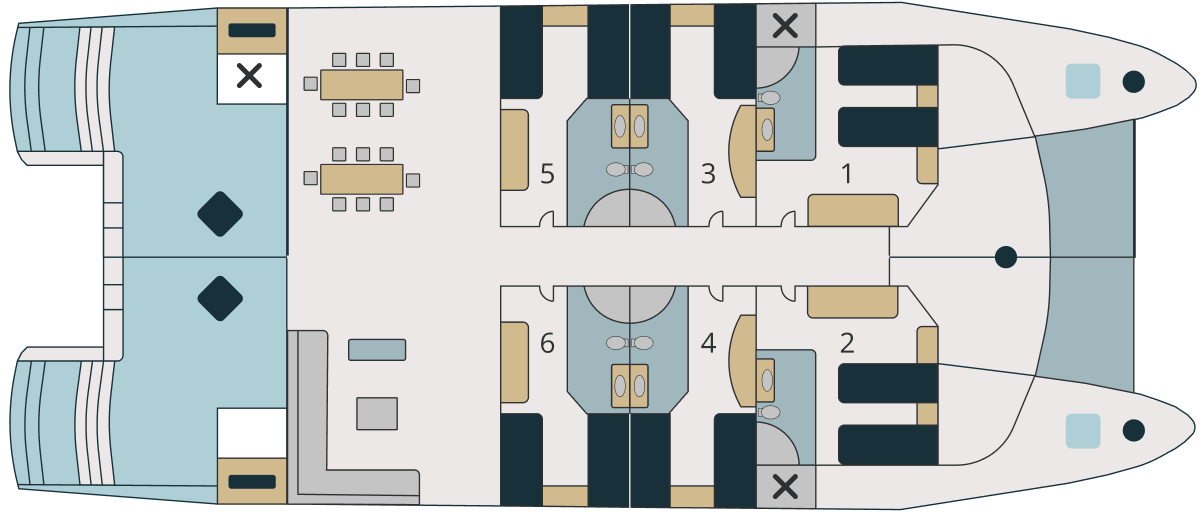
Main Deck
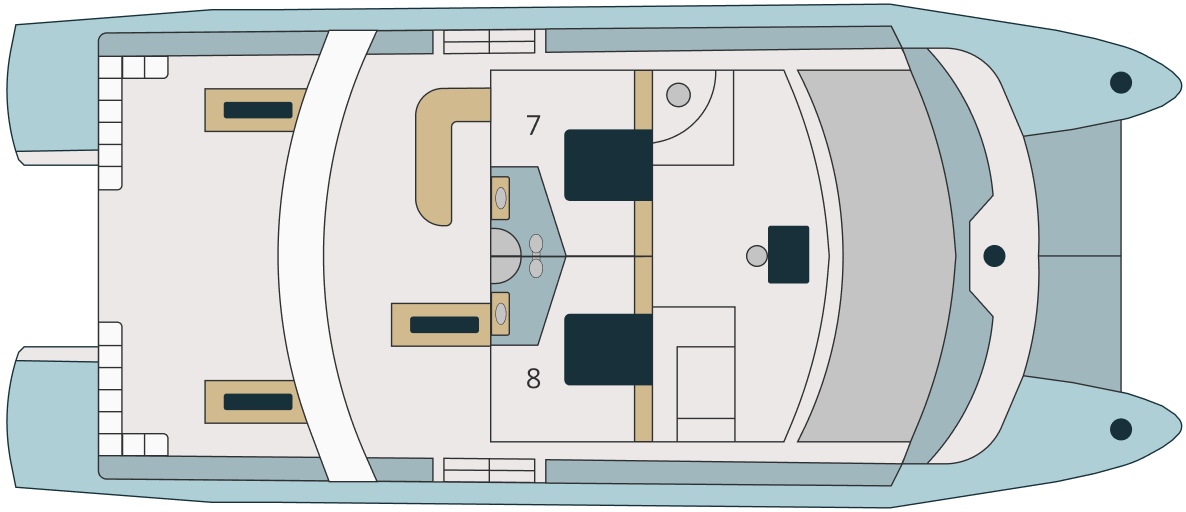
Upper Deck
Situated 1,000 kilometers (600 miles) off the coast of Ecuador, the Galapagos archipelago consists of 19 islands and more than 40 islets, created six million years ago when they emerged from the Pacific in a flurry of volcanic activity. The islands were discovered in 1535 by Tomas de Berlanga, who sent the first known description of the Galapagos to the King of Spain: “…nothing but seals, and turtles, and such big tortoises that each could carry a man on top of itself, and many iguanas that are like serpents”. He also remarked on the tameness of the creatures: “…so silly that they do not know to flee, and many were caught in the hand”.
Perhaps our first association with the word “Galapagos” is the name “Darwin” – and for good reason. He sailed into the Galapagos Islands in 1835 on board the Beagle and was amazed by the extraordinary life he found on the islands. Each island forms a unique ecosystem, a series of specialized relationships that have adapted to the volcanic and isolated nature of the islands. As a result, the Galapagos Islands are home to a wide variety of endemic species.
It has been more than 450 years since their discovery, yet the islands remain largely intact thanks to the conservation efforts of the Galapagos National Park and the Charles Darwin Research Station. A further boost to the protection of the islands was given in 1978, when UNESCO declared them a World Heritage Site. The waters around the Galapagos, which are the lifeblood of the archipelago, are also legally protected within the Galapagos Marine Reserve, making the islands one of the best places on the planet for scuba diving.
The Galapagos Islands offer a unique interaction with nature, and their name is synonymous with survival and the celebration of the diversity of species on earth.
